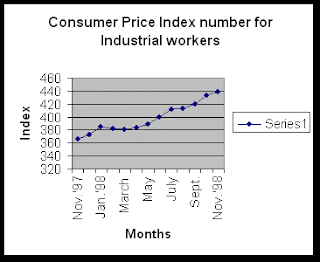MEASUREMENT OF THE CHANGING VALUE OF MONEY :-
The value of money has opposite relation with the price level in the country. When the value of money falls the level of prices rises. As the prices falls value of money increases. The statistical method of computing changes in the value of money is called index number.
DEFINITION OF INDEX NUMBER :-
Index number is an instrument which measures the average price movements of a number of selected commodities.
Index number of prices measures the changes in the value of money.
THE CONSTRUCTION OF INDEX NUMBER :-
Construction of index number is a complicated process. The main steps for the construction of index number are following :
1. Purpose Of Index Number :-
If we do not have any purpose in mind, the selection of commodities, selection of markets and relation of base period is useless. So first of all we will have to fix the object of index number.
2. Selection Of Commodities :-
For the construction of index number it is necessary to include only these commodities which are most commonly used by that class of people for whom, the index number are constructed. For example poor class uses vegetables, so we will have to select this at the time of construction.
3. Selection Of Markets :-
If we want to construct the cost of living index number of rich class, then we will have to choose those markets where this class goes for shopping.
4. Price Quotations :-
The prices of commodities vary from place to place and from shop to shop in the same locality. It is not possible to collect prices from cash and every shop in the selected market but we should take into account the whole sale prices and not the retail prices.
5. Choice Of Base Period :-
There are two methods for selecting the base period. One method is the selection of certain year as a base year. While the other is chain base method. Some times a normal year prices are neither too high nor too low as compared to the previous years.
Fixed Base Method Formula = Price for the current year/ Price for the base year x 100
Chain Base Method = Price in the current year/ Price of the previous year x 100
6. Choice Of The Average :-
After computing the link relative, their average is taken to get the required index number. The average in the base year will be always 100. If average in the subsequent year is high indicates the rise in the general price level otherwise it will show fall in the price level.
7. Choice Of Weight :-
While constructing index number proper weights are given according the importance of different commodities. More important commodity will get more weight. Because of a rise in the prices of essential commodities the poor consumer is more affected then others.
Following are the methods which are generally :
1. Weighted aggregate method.
2. Weighted average of relatives.
8. Average Of Price Ratio :-
An average of the prices of the commodities can be calculated in many ways. Usually Arithmetic mean and Geometric mean is used.
The following table shows that how an index number is constructed.
Formula P/PO x 100 = PO = Price of Current Year = Price of the base year


Average = 500/5 = 100
Average = 620/5 = 124
The above index number shows that the prices of 2000 as compared to the price of 2003. One person can purchase as many goods in 2003 with Rs. 124 as one could purchase with Rs. 100 in 2000. The above noted index number is called UN-weighted index number. While constructing such index number every commodity is given the same importance. But the people do not give same importance to the commodities. The each commodity must be given a weight according to its own importance. Now we construct the weighted index number, according the
Weighted Aggregate Method
Formula : P1q0/ P0q0 x 100
P1 = Price for the current year.
P0 = Price for the base year.
q0 = Quantity of the base year.
EXAMPLE : COMPUTE WEIGHTED INDEX NUMBER :-
By using weighted aggregate method from the following data taking base year 2000.

Weighted Index Number = P1q0/ P0q0 x 100
Weighted Index Number = 10750/ 7750 x 100
Weighted Index Number = 138.83
EXAMPLE :-
Calculates the weighted index number by using weighted average relatives.
Formula :
1V/ V
V = P0q0
I = P1/ PO x 100
I = P1/ P0 x 100 = P0Q0


Weighted average index number for the current year 2000 = 1074890/ 7750 = 138.83
According to the weighted index number there was a rise of 138.83% rise in the general price level in 2003 as compared to 2002.
DIFFICULTIES IN CONSTRUCTION
1. Assignment Of Weight :-It is very difficult to assign weight to each commodity according to its importance in national consumption. For example wheat is more important for poor and also important to rich people.
2. Changes In Taste and Traditions :-
From year to year taste and traditions changes. So the measurement of the value of money may not give accurate results.
3. Choice Of Base Year :-
It is also very difficult to choose a normal year as a base year.
4. Difficulty In The Preparation Of Cost Of Living Index :-
It is very difficult to construct the cost of living index number for every person and every class because their consumption taste is different.
5. Retail Prices Problem :-
We take retail prices because these are more representative but it is very difficult to obtain the retail prices because these are not uniform.
No doubt there are so many difficulties in the construction of index number but it is fact that these are very helpful in measuring the value in the short run.









0 Comments